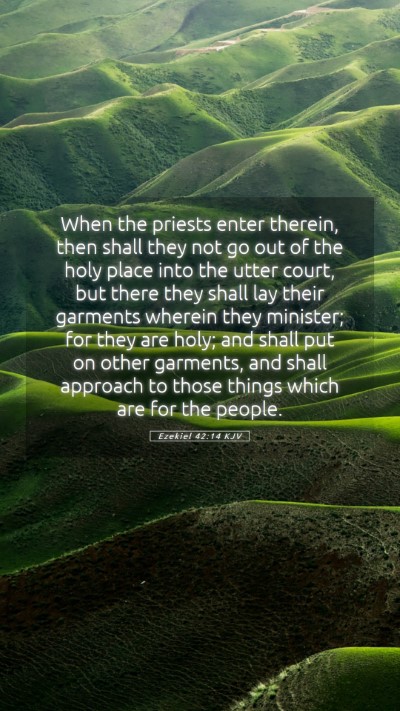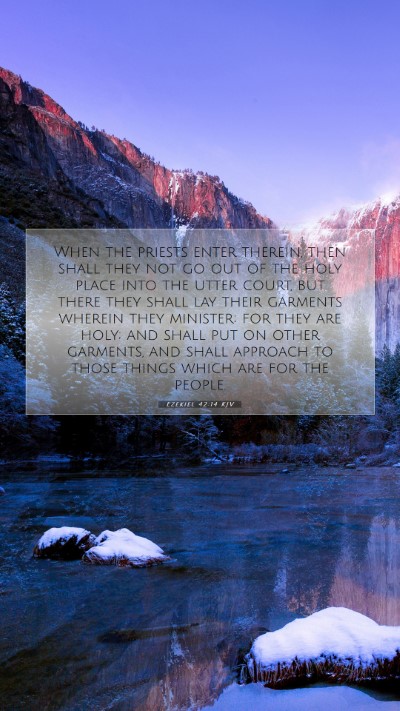Ezekiel 42:14 - Bible Verse Meaning and Explanation
This analysis offers a comprehensive understanding of Ezekiel 42:14, drawing insights from esteemed public domain commentaries, including those by Matthew Henry, Albert Barnes, and Adam Clarke. It aims to provide clarity on the verse's significance within the broader context of Scripture, aiding readers in their Bible study endeavors.
Verse Text
Ezekiel 42:14 (KJV): "When the priests enter therein, they shall not go out of the holy place into the utter court, but there they shall lay their garments wherein they minister; for they are holy; and shall put on other garments, and shall approach to those things which are for the people."
Overview of the Context
The book of Ezekiel primarily addresses the Israelites during their Babylonian exile, focusing on prophecies of judgment and restoration. In this specific chapter, Ezekiel describes dimensions and regulations concerning the temple and its priests, as part of a vision detailing God's covenant with His people. This grounding in historical context is crucial for a thorough bible verse explanation.
Commentary Insights
-
Matthew Henry's Commentary
Matthew Henry emphasizes the sanctity of the priests' duties. He highlights that entering the holy place requires a separation from the common or profane. This underscores the concept of holiness that pervades the temple regulations, reinforcing the necessity for priests to be both clean and ceremonially appropriate when serving in sacred spaces.
-
Albert Barnes' Notes
Albert Barnes interprets this verse as a directive on the handling of priestly garments. He notes that these garments, worn in holy ministrations, must be treated with respect as they symbolize the priest's role. By laying them aside before entering public spaces, the verse signifies a transition from sacred to secular, emphasizing a distinct separation in Israelite worship practices.
-
Adam Clarke's Commentary
Adam Clarke elaborates on the implications of the priest's attire. He remarks that the garments worn in the temple are not meant for general use, fostering a mindset of reverence among the priests. Further, he equates this with the need for spiritual readiness and purity when approaching God on behalf of the people, reflecting the essence of biblical exegesis.
Thematic Analysis
This verse speaks to several key themes within biblical texts:
- Holiness: The dedicated nature of the priest's garments and the separation they signify emphasize the importance of holiness in worship.
- Role of Priests: This verse defines the duties and responsibilities of the priests, illustrating their intermediary role between God and the people.
- Transition and Rituals: The prescribed actions demonstrate the need for specific rituals in approaching God, reflecting broader themes present throughout the Old Testament.
Application of the Verse
Understanding Ezekiel 42:14 allows believers to appreciate the necessary precautions and attitudes required when approaching God. In contemporary applications, this can translate into:
- Taking Worship Seriously: Just as the priests approached their duties with reverence, modern believers can reflect on their preparation and mindset before engaging in worship.
- Recognizing Roles in Community: The distinctions made among the roles in the biblical narrative remind Christians today of the various responsibilities and gifts within the church community.
Cross References
Related scriptures that provide further insight include:
- Exodus 28:2-4: Discusses the priestly garments and their significance.
- Leviticus 16:4: Calls attention to the ceremonial use of garments during rituals.
- Hebrews 7:26-27: Reflects on the holiness of Christ as our high priest, connecting Old Testament practices to New Testament understanding.
Conclusion
In conclusion, Ezekiel 42:14 serves as a vital reminder of the importance of holiness in approaching God. By applying these lessons to our lives today, we can gain deeper bible verse understanding and enrich our Bible study insights. Engaging with such passages prompts thoughtful reflection on the significance of ritual and garment symbolism in our relationship with the divine.


